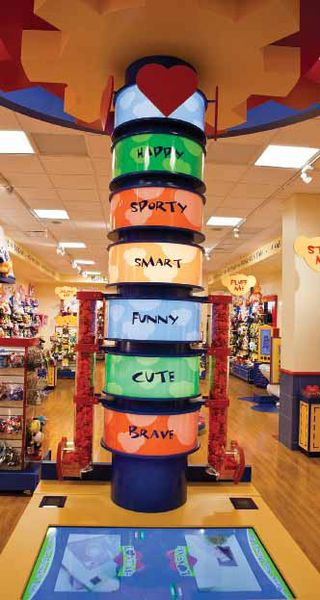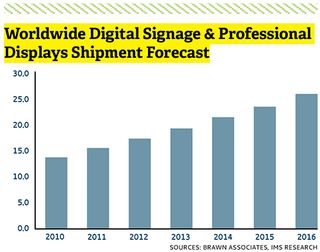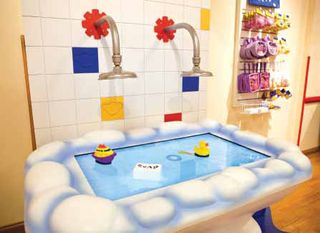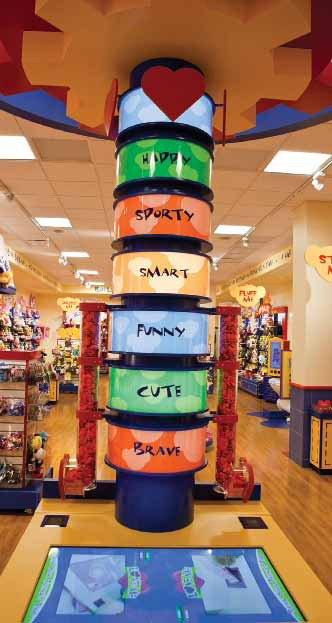
Traditional stuffed animals meet high-tech amenities in the Build-A-Bear Workshop. Photo courtesy of the Build-A-Bear Workshop. Outside McDonald’s restaurants in Stockholm, Sweden, smartphone users can play a game on a giant billboard. Lucky winners can redeem McDonald’s coupons for free snacks.
In England, McDonald’s restaurants feature interactive, gesture-based digital floor games linked to the chain’s “Happy Meal” promotions.
And in the U.S., Build-A-Bear Workshops have outfitted select stores with Samsung touchscreens with Microsoft brains. Once inside the Build-A-Bear stores, customers are discovering that the bear-making stations have gone interactive. The digital bathing station, for example, bubbles up with digital suds and waves that are activated when an optically tagged toy is placed on the screen. It’s interactive game-play for the digital generation.
According to Brandon Elliott, Build-A-Bear’s director of digital ventures, the concept is to combine children’s natural love of huggable teddy bears with the best digital technology experience. The new stores will be expanded from six to some 50 locations by the end of 2014, Elliott said. The addition of interactive technology has not only amped up the “wow factor” for customers, it has boosted company sales.
“It’s all about engaging with customers,” added Kevin Schroll, senior product manager, large format displays, Samsung Electronics America. Samsung’s SUR40 technology is a key component of Build-A-Bear’s storefront, the bear bathing station, and checkout station interactive touch features. The digital signage isn’t part of what is being “sold,” but it elevates the user experience to a new, compelling level.
“[Today’s] kids are playing with iPods,” Schroll explained. “If companies don’t integrate technology into traditional toys, the [manufacturers] will lose them.”
Digital signage has been around since the 1990s, but its deployment has exploded over the last five years, growing more than 20 percent a year, a staggering figure considering the U.S. recession. According to Alan Brawn of Brawn Consulting Inc., digital signage has recently emerged from the early adopter phase and is entering into mainstream adoption. Interactivity and audience engagement are playing critical roles in growing this technology category.
DIGITAL SIGNAGE DRIVERS—WHAT IS FUELING THE GROWTH?
The recent rapid growth of digital signage is due to a confluence of factors: dramatic innovations, lower hardware and software costs, and greater integration and ease of use.
For starters, signs aren’t just a few standard sized rectangles any more. Christie MicroTiles, in particular, makes digital signage of any size and shape, even curving around walls and columns. NanoLumens also makes flexible, bendable high-resolution digital signage products.
A second factor in the category’s growth, according to Schroll, is the big drop in bezel width, which, in turn, narrows the space between tiles, making video walls possible. Samsung explored the limits of this technology by transforming the lobby of the Las Vegas Continental Hotel into a moving art gallery displayed on floor-to-ceiling paneled columns, a project for which Samsung won an international award in 2011.
BRIGHT IDEAS
Lighting innovation also has been a key advance, with backlit LED signs costing half as much to run as conventional cathode fluorescents, Kevin Schroll said. LED systems also are easier to install and deploy and don’t protrude from the wall, he added.
EASIER MEDIA MANAGEMENT
In addition to lighting enhancements, more display systems now are integrated with media players and other hardware, reducing complexity of installation and maintenance. And now that digital signs display continuously refreshed content, they attract more attention, which, in turn, increases their usefulness for branding and helps justify the ROI, Schroll said.
THE QR CODE CRAZE
Another development in digital signage is the introduction of new interactive display technologies that go beyond simple touch, Schroll said. Samsung’s SUR40, for example, enables Build-A-Bear’s interactive stations to differentiate objects by QR codes and ,pixel recognition, collectively enabling the station to “see” what’s on it and perform a specific activity.
“We’ve changed the game of touch technology and made the experience a lot more engaging,” he said.
But retail isn’t the only vertical aware of the engagement potential of digital signage. Corporations and manufacturers are catching on, too, using it to improve communication and boost morale.
BEHIND THE SCENES AT DOW CHEMICAL CO.
More than 30 years ago, the global chemical manufacturing company headquartered in Midland, Michigan, recognized the value of networked TVs to communicate with its 52,000 employees. But the information in the early years was very basic and location specific: road closures, volunteer opportunities, and the like.
The big push to improve content came in 2004 when the company decided to replace its aging coax infrastructure with an IP network, explained Chris Duncan, Dow’s director of communication resources and Studio 20/20. With the new IP network able to support HD broadcasts, the AV team recognized that the time was right to put more effort into upgrading content, he said. And so they did.
The network now broadcasts animated weather, local sports scores, and an automated news feed as well as volunteer opportunities, and teasers for company HR and product news available on the intranet, Duncan said.
“The key is to include news of personal interest, like cricket scores in India, so they look at the other stuff on the intranet,” he said.
Information is processed centrally using the Scala content management system and distributed to large flat screens in 30 locations, some in Dutch and German, he said. All the channels are fed simultaneously to multiple platforms: digital signage, intranet, video-on-demand, and live video to the desktop.
The AV staff of four or five doesn’t generate content, but it does provide general guidelines of what is acceptable for user-generated content, Duncan added. For example, no ads for local businesses, videos of co-workers or copyrighted materials will be allowed.
Although results of its digital signage outreach are hard to measure, the AV staff at Dow Chemical does get feedback from an annual employee survey, Duncan said. Other indicators are the time it takes for employees to report an outage and the speed with which the auditorium fills for a guest speaker.
BEST PRACTICES FOR THE BEST CONTENT
When planning digital signage initiatives, AV staffs should keep in mind that companies outside the retail sector don’t have to match the cost or sophistication of the McDonald’s billboards or the Build-A-Bear stations to effectively “engage” their audiences.
“The belief that the latest and greatest digital signage will win is not true,” said Bryan Meszaros of Open Eye Consulting.
To the contrary, a practical, common sense approach that delivers the right message to the right audience with the right vehicle is the key to successful engagement, Meszaros said. Ask questions like: Who are the right people to be involved in the project? What information is the customer seeking? And how long will they be there?
Although AV staffs typically do not produce the content, they are the technical experts who ensure that the signage is sized correctly for the content, which many times has to be rewritten for large format displays, especially if it’s not a flat surface, he said. AV staffs should take content teams to the physical location where the signs will be placed so they can view the content in the environment where it will be displayed, which will look quite different from its appearance on a computer screen, he advised.

Budgets can be another pitfall. Sometimes companies will wipe out the entire signage budget with one large screen or make the opposite mistake: buying many bargain-priced screens that soon fail, Mezaros said.
“It’s better to have 75 quality sites than 200 sites with problems,” he explained.
NETWORK IMPACT AND REMOTE MANAGEMENT CAPABILITY
AV staffs across the commercial spectrum also have a critical advisory role in signage maintenance costs, network impact, and remote management capability, Mesaros said. In addition, AV staff should make sure to budget for a content management platform that processes all types of video and data so it only has to be formatted once.
One final warning: AV often misses the importance of buying software that can grow with the organization and integrate data from other sources as needs change, he added.
A NEW VALUE PROPOSITION
Brian Kutchma, vice president of sales and marketing at Black Box, said the best content is interactive, visual, and entertaining. If signage is relevant and offers information that people want to know, it has a higher chance of capturing mindshare. In spaces like lobbies with high traffic areas, use simple visuals with a key message that can be absorbed in just seven seconds, he said. In cafeterias and other areas where people remain for longer periods, use video, flash or TV.
In locations in between those extremes, like a bank lobby, the best approach is to rotate simple but eye-catching content such as local news and weather, a stock ticker, smart financial tips, the bank’s top goals, ways to save money, fun facts and entertaining clips, he said.
Black Box walks the talk, running an effective internal display program for $10,000 a year, Kutchma said. The best approach is to hire an expert to map out a plan and a strategy, then get creative in scouting out free or inexpensive content from the Internet, as well as local news and weather stations or a local art museum or chamber of commerce. Broadcasters and other organizations often will be willing to provide feeds and other content free, if you credit them as the source, he added.

Interactive technology isn’t being “sold” at Build-A-Bear, but it elevates the customer experience to a new level. Pictured above is the digital bear bathing station, featuring the Samsung SUR40. A digital signage program doesn’t have to be expensive, Kutchma explained. A base model, including a screen, starts at about $3,000, while a hosted model is under $1,000.
Black Box makes the process of adding content and distributing it over the network much easier, Kutchma said. Black Box’s iCOMPEL content management appliance, which starts at $3,000, can capture and format media from any source, including the Internet. Additionally, Black Box’s networking expertise assures that customers have the right hardware to reach the desired distance. Third, when a problem occurs, Black Box knows how to fix it, a task that is far more daunting with multiple vendors, Kutchma said.
Meszaros, however, disagrees. Although it’s easy to get comfortable with a particular vendor, bestof- breed hardware components are a better option because you can keep up with the latest trends; they may also be less expensive, he said.
“I made that mistake and put blinders on,” Meszaros said. “Look at different agnostic solutions and find what suits you best.”
INTERACTIVE CONTENT AT LA ROCHE COLLEGE
Located in Pittsburgh, PA, La Roche College features five digital signage screens managed by Dave Siroki, webmaster and coordinator of Internet communications at the school. Faced with the challenge of students “tuning out” static content, the college is now using Black Box’s iCOMPEL platform to integrate dynamic social media, resulting in more interest in the signage and more awareness of campus events/services.
This social media phase of the digital signage implementation began in 2001. At that time, the college wanted to better communicate information via signage in its fitness center and library, and at its welcome desk. To accomplish this, it decided to address students in an “individual” way using content fed from the college’s official Facebook and Twitter pages. When a student “likes” or comments on a post appearing on the college’s Facebook Internet page, their name automatically appears on a scrolling signage page (although the exact post they have “liked” or commented on isn’t shown). They are subsequently brought into the social media experience—even when they’re not accessing the pages via the Web.
Layouts promoting campus events and services are replaced by layouts showing Facebook and the Twitter feeds intermittently throughout the day. Students in the process of checking a screen to see who has a “liked” a particular post are more likely to receive more important institution-related content.
HOSTING OPERATIONS VS. IN-HOUSE
For a really large network, say 3,000 to 4,000 signs, it’s cheaper to run them in-house, Meszaros advised. But for only a few hundred signs, it’s more cost-effective to use a hosting service, he said. Even if your firm outsources the entire operation, AV will still be involved.
Pam Derringer is a frequent contributor to AV Technology magazine and Tech & Learning.
Nine Tips for Content Engagement
By Michael Ferrer
Here are some tips for getting the most from your video wall deployments:
1 DETERMINE YOUR DIGITAL SIGNAGE NEEDS AND GOALS—It’s important to give strong consideration to the video wall’s purpose, size considerations, and client goals. Will the video wall be used for branding, advertising, wayfinding, or something else? Will it be interactive?
2 CONTENT IS KING—Determining the Number of Images for Display at One Time. Talk about the types of content to be shown before the hardware gets installed. You don’t want to be tweaking content on-the-fly minutes before a grand opening. Also, in what resolutions and formats will the content be designed? It’s imperative to have this conversation with the content creators up-front.
3 GO NATIVE—Content needs to match the screens with native resolutions. All the hardware components should match so you don’t have bandwidth restrictions. Some graphics cards can’t handle full HD. Flash has limitations. You need experts involved to stretch Flash content with native resolutions, for example.
4 CHOOSE PROFESSIONAL-GRADE PRODUCTS—Use displays that can be color calibrated to achieve brightness and color uniformity from screen to screen. Industrial-strength monitors can handle the most rugged of applications, while consumer-grade products sold at “big box” stores don’t run 24x7 and can’t handle commercial demands. Go with high-end products for their reliability, inputs and color calibration capabilities.
5 CHOOSE APPROPRIATE MOUNTING SYSTEMS/ACCESS FOR MAINTENANCE—This is very important since labor is the most expensive part of any video wall project. Is the existing wall structure sound? Get a structural engineer involved to make sure that it can support a video wall. For the maintenance portion, ensure that you use pull-out mounts to service the video walls correctly and safely.
6 KEEP IT COOL—Video walls produce a lot of heat. Proper cooling and ventilation need to be part of the overall project and budget. Purchasing displays that offer integrated cooling fans will ensure unfailing operation.
7 DETERMINE ELECTRICAL REQUIREMENTS—Make sure you have thought through all the necessary components for the video wall system. If you’re deploying 15 screens, you can’t power them off of one outlet. You need dedicated power. If you're a hotel, you don't want to turn on the microwave in your kitchen and discover that your video wall has shut down. Discuss power conditioners and surge protection with your systems integrator.
8 USE TRAINED PROFESSIONALS FOR YOUR VIDEO WALL INSTALLATION—Do yourself a favor and connect with an experienced partner for the installation. That partner will help you locate power sources and data jacks, and help you do the job correctly the first time.
9 PERFORM COLOR CALIBRATION AS PART OF SYSTEM MAINTENANCE—This will ensure a consistently great-looking video wall for years to come. Also make sure you budget maintenance and cleaning of your video wall to ensure functionality and a great look for the long term. If you don’t vacuum vents, for example, the ensuing heat accumulation can destroy the monitors. Maintenance contracts should be discussed upfront.
Keeping this checklist in mind can help you make the most of your video wall and endear you to core audiences and bosses alike.
Michael Ferrer is national manager of solutions sales and operations for NEC Display Solutions and a former systems integrator. He can be reached at mferrer@necdisplay.com.
GO FIGURE - Earlier this year, based on the first stand-alone measurement of smartphone ownership, the Pew Internet Project reported that more than one third of American adults (35%) own smartphones, or have phones that operate on a smartphone platform (39%). At the end of 2011, InfoTrends confirmed that year-over-year smartphone adoption rates had doubled. These statistics suggest that there is a huge opportunity, both for marketers and for those who operate digital signage networks, to leverage this ubiquitous technology.
Ten Trends to See at The Digital Signage Expo 2013
1. LCD EXPANSION INTO OUTDOOR MARKETS
2. 4K DIGITAL SIGNAGE
3. ANALYTICS-DRIVEN DIGITAL SIGNAGE
4. AUGMENTED REALITY TECHNOLOGY
5. HTML5 FOR CONTENT DEVELOPMENT
6. LIVE VIDEO FEEDS
7. TABLET TECH
8. CONNECTED CONSUMER
9. INTERACTIVE DIGITAL SIGNAGE
10. AUTOMATED RETAILING/INTELLIGENT VENDINGRead more about these notable trends and register for February’s DSE 2013 at www.DSEnow.com.
More info:
BLACK BOX
www.blackbox.com
FOUR WINDS INTERACTIVE
www.fourwindsinteractive.com
GEFEN
www.gefen.com
HAIVISION
www.haivision.com
LG
lg.com/global
MITSUBISHI
www.mitsubishi-presentations.com/digital-signage-monitor
PANASONIC
www.panasonic.com
PLANAR
www.planar.com
NEC DISPLAY SOLUTIONS
www.necdisplay.com
SAMSUNG
www.samsung.com
SHARP
www.sharpusa.com
SONY
www.sony.com
VIEWSONIC
www.viewsonic.com
X2O MEDIA
www.x2omedia.com










